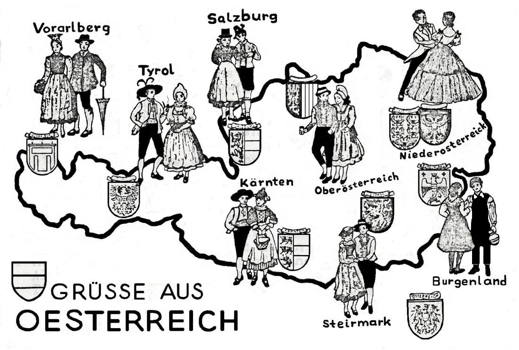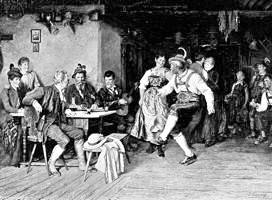
|
The Society of Folk Dance Historians (SFDH)
Austrian Courting-Type Dances
[
Home |
About |
Encyclopedia | CLICK AN IMAGE TO ENLARGE |

|

The simplest form of Austrian courting-type dances is the man turning the woman under his raised hand, eight measures, in front of himself and spinning her like a top. In this way, most of the Almerischen (Landler figure dances) begin. The turning of the woman must be very old, the wild Swiss Urs Eraf recorded this in 1525 on a sheet of paper. This can also be seen in Farmer-Breughezs paintings. Eight measures of drehing (turning), alternating with eight measures of round dance in closed position forms the content of that style, of simple Almerish-Wallnerisch dancing that emerges under the name of Schöns Dirndl, drah di um (waltz from Steirmark) in lower Austria, Styria, and Carinthia.
 Only in two areas do I know of the further development of such simple play of the joined hands to an artistic diversity: in the Austrian alpine, southwest Germany, and in Norwegian courting dances. Austria reaches the peak. Ever new possibilities come to light. Besides here, there are two different development strains. The one way – and it is certainly the most original – aims at the continuous flow of movement. Names such as Wickeln (wrap), Scheiben (discs), and Radl (bicycle) indicate this. The other types, from the flow of movement, in which every position is only a transition done in a fleeting wink to form a position, to hold it, and in this fixed position to dreh (turn) in place. Whether it be in Muhlen (mills), Fensterl (window), or Herzerlstellung (heartform). It is also to a certain extent a pose that aims more at the spectator than is made visible. The Steirische (Styrian) of the Salzkammergut is, besides decidedly a community form, in which all couples dance at the same time the same sequence of figures, whereupon the singing and paschen (clapping) of the men all together follows.
Only in two areas do I know of the further development of such simple play of the joined hands to an artistic diversity: in the Austrian alpine, southwest Germany, and in Norwegian courting dances. Austria reaches the peak. Ever new possibilities come to light. Besides here, there are two different development strains. The one way – and it is certainly the most original – aims at the continuous flow of movement. Names such as Wickeln (wrap), Scheiben (discs), and Radl (bicycle) indicate this. The other types, from the flow of movement, in which every position is only a transition done in a fleeting wink to form a position, to hold it, and in this fixed position to dreh (turn) in place. Whether it be in Muhlen (mills), Fensterl (window), or Herzerlstellung (heartform). It is also to a certain extent a pose that aims more at the spectator than is made visible. The Steirische (Styrian) of the Salzkammergut is, besides decidedly a community form, in which all couples dance at the same time the same sequence of figures, whereupon the singing and paschen (clapping) of the men all together follows.
In Salzkammergut, there are namely no less than three related dances of this type danced; the Schleunige (speedy), the Landler (lander), and the Steirische (Styrian). The most rigid community form is the Schleunige. It has a decidedly male characteristic, with its stamping, jumping, and walking. In the Landler, the man begins to draw the woman into the dance. This, too, is still a community form, but the couple dance character develops stronger and stronger. The typically male leg movements retreat, for it the arms come into more dance use in the dreh (turn) and twisting and wrapping movements.
In the Steirischen, on the other hand, the man dedicates himself completely to leading his partner. Thereby, the dance is more tender and gentle and in a certain sense, femininely tinged. The arms, which in the Landler is in the belt or shoulder level, accentuating the horizontal, are now raised over the head, whereby the wrapped figures have an airy graceful effect. The forward movement is only hinted at. Strong leg movements, as in the Schuhplattler, and many of the hops of the Landler-kind of dance, are completely missing here. All actual movements are carried out by the upper torso and arms. Therefore, the wrapping and twisting possibilities are created to the highest art. The dances of the land in front of the Alps remain simpler and the most original and mostly consist of only two to six figures – Invierteler (quarterer) and Steinhäuser (stone houses).
The Almerische or Steirische begins usually with the man turning the woman under his raised hand. In the land in front of the Alps, the man circles his woman, doing it often in opposite direction. Then both hands are joined and twisted in many ways. Often, the man leads the woman also around himself. Then, they again both turn under their joined hands, the so-called Walgen (dishcloth). This can be interrupted so that the woman comes to stand in front of the man. The hands remain joined over the shoulders of the woman. With each step they look at each other a little, in which the woman turns a bit once to the left then to the right. The figures in which they remain for a while mostly have their own names, such as Joch (yoke), Herzerl (heart), Mühle (mill), Fensterl (window), and Knoten (knot). The great Steirischen Figuren dances, in which each couple simultaneously make the same movement and which have grown in munber to 37 figures, obviously present the highest development stage under the influence of the Trachtenvereins (costume clubs).
Where dancing is well done, all of the movements proceed in a beautiful flow into one another. Even the Ubersteigen (stepping) over the joined hands of the one partner, who must thereby bow or bend down – possibly to come out of the wrapped-up position without breaking the hold – should not entail any long hesitation. Only choreographed, artificial dances break the movement. Thus, in the dance of I. Daigl in Jundenburg, in which he gathered together figures from the various areas of the Steiermark, and then altered them in various ways, he increased the number of figures in the dance with five figures of his own invention, and even in the Bankerl (banker) figure, in which the woman sits on the knee of the man, it can easily be recognized that the dance is an artificial product.
It is, by and large, a question of taste, whether one wants to sit intimately with his sweetheart on a bench in front of other people, or if he would rather be where he can be alone and undisturbed by anyone. I find that what you wouldn't do in real life should also not be done in dance. Above all, such a display is absolutely unlike the farmer's ways. Even where a couple might very well be together by night in Fensterln (window courting), they certainly do not show this by day, and as a matter of course. That is a traditional, handed-down law. A dance, therefore, that goes against this law, shows itself through this very defiance to rule as unauthentic – not genuine. It is unnatural that at exactly the same time, the whole group kisses in certain figures. It can very well happen in particular highpoints of the dance that two who know each other very well may give a kiss out of pure joy. But not as show or act on a stage and not exercised to a certain measure.
The ending or conclusion of the Almerischen by way of the round dance is in a closed position. The music proceeds without exception in 3/4 time and binds mostly two parts to every eight measures. The old form lined up as many as six such Landler parts with each other and in between played the cadence of an ausgang (lead-in), in which the man let go of the woman and stamped rhythmically.
The Landler of Oberöterreich, the dance of the hard and heavy grain earth, is from the plains and the gently undulating hilly land. Today, it is accentuated by the young men's groups and is carried on by them. Justifiably, it is called the Ländler. One can distinguish them from the so-called Landl (rural), which is the heartland of the Oberösterreich, or, however, with E. Hamza from a general differentiation. The "land" means, in our dialect, namely the general plains, as opposed to the mountains.
The dancing of the Landler entails much effort until one can master it.
"Not everyone can dance the Landlerisch.
I can't myself, but my brother can."
Because in the Landlerischen, the woman's role is quite an undertaking, and is generally underplayed. As in the farmer's dances (or peasant's dances) of the 15th and 16th centuries, or on the Norwegian Springing Dances, the man leads the woman out by the hand, and turns her around himself once. Basically, the woman only comes along with the man. The men are the ones who play the lead role. They make the twisted-up step forms, and it is only the men who sing. During the entire dance, they scarcely give the woman even a glance To a certain extent, they dance "for themselves." It is a very masculine dance, which nothing else of the courting nature is tacked on.
The movement of the whole group is accomplished in completely even-measured swinging and walking. In the evenness of the movement lies the highest art accomplishment, in which the Innviertel has carried this to its highest stage. According to even its complete carriage of the Landlerisch is a decidedly noble dance. And here it doesn't only count solely on watching the play of the hands, but also on the various styles of steps and hops. In the Traunvierteler Landler, for example, the tip of the foot is placed in a way as if it is used as a stop, and then with the same foot you step out – it is the so-called "kick-off" or the Wischer (wiper) follows, in which the sole of the foot is shuffled over the floor in the step forward. The Sprung (leap) is mostly only a slight rocking motion, and more seldom an actual jump. On the other hand, in the Innviertel, one really hops, during which one bends the other leg at the knee joint and inclines it toward the back and the like. That is primarily the distinguishing feature of the two most important Landler types in Oberösterreich, the Traunvierteler is "shuffled" and the Innvierteler is "hopped."
BIBLIOGRAPHY
- History of Austrian Landler from "Die Volkstänze in Öesterreich und verwandte Tänze in Europa," by Dr. Richard Wolfram, 1951.
DOCUMENTS
- Austria, a country.
- Austrian Dance, an article.
- Morry Gelman, an article.
Printed in the 1982 San Diego State University Folk Dance Conference Syllabus.
This page © 2018 by Ron Houston.
Please do not copy any part of this page without including this copyright notice.
Please do not copy small portions out of context.
Please do not copy large portions without permission from Ron Houston.